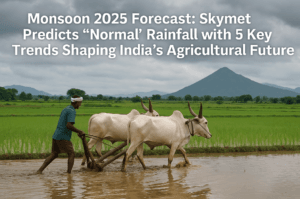Monsoon 2025 Forecast: Skymet Predicts “Normal” Rainfall with 5 Key Trends Shaping India’s Agricultural Future
The season may start weakly due to the rapid transition from La Niña to ENSO-neutral conditions but is likely to strengthen by mid-July, aided by a developing positive Indian Ocean Dipole (IOD) that historically enhances monsoon performance. While western and southern regions, including Kerala, coastal Karnataka, and Maharashtra, could see above-average rains critical for agriculture, northeastern states may face below-normal rainfall, impacting water resources and crops like tea.
Central India, including Madhya Pradesh, is poised for adequate precipitation, supporting key crops such as soybeans. The absence of El Niño reduces risks of major disruptions, offering optimism for farmers and policymakers. However, uncertainties like localized dry spells or cyclones remain challenges. Overall, the forecast signals stable agricultural prospects and economic stability, though adaptive planning will be vital to address regional disparities and climate variability.

Monsoon 2025 Forecast: Skymet Predicts “Normal” Rainfall with 5 Key Trends Shaping India’s Agricultural Future
Private weather agency Skymet has projected a “normal” southwest monsoon for India in 2025, offering cautious optimism for the agriculture-dependent economy. The forecast anticipates rainfall at 103% of the long-period average (LPA) of 868.6 mm, with a margin of ±5%, placing it squarely within the “normal” range (96-104% of LPA as per India’s meteorological standards). While the season may begin sluggishly, experts predict a stronger second half, driven by shifting climate patterns.
Key Drivers of the 2025 Monsoon
- ENSO Transition:
- A rapid shift from La Niña (cooling of Pacific waters) to ENSO-neutral conditions is expected to temper early monsoon activity. However, the absence of El Niño—a known disruptor of Indian rains—reduces the risk of significant deficits.
- Positive Indian Ocean Dipole (IOD):
A developing positive IOD, characterized by warmer western Indian Ocean waters, is likely to complement ENSO-neutral conditions. Historically, this combination has bolstered monsoon performance, particularly in central and western regions.
- Regional Rainfall Distribution:
- Excess Rainfall Zones: Western Ghats states, including Kerala, coastal Karnataka, and Goa, may see above-average rains, benefiting cash crops like coffee and spices.
- Adequate Rainfall: Maharashtra and Madhya Pradesh, critical for soybean and cotton cultivation, are expected to receive sufficient precipitation.
- Below-Normal Areas: Northeastern states and Himalayan regions could face drier conditions, potentially impacting tea production and water resources.
Monsoon Progression and Implications
The season is likely to begin weakly in June due to the lingering effects of La Niña’s transition. However, momentum is expected to build by mid-July, aligning with peak sowing periods for kharif crops like rice and pulses. Jatin Singh, Managing Director of Skymet, emphasized, “ENSO-neutral and positive IOD conditions create a safety net, reducing the likelihood of extreme monsoon failure.”
Broader Impacts:
- Agricultural Planning: Farmers in rainfed regions could leverage the forecast to optimize planting schedules, though delayed onset may require short-term adjustments.
- Water Security: Reservoir replenishment in western and southern India may improve hydropower output and drinking water availability.
- Economic Ripple Effects: A normal monsoon supports rural demand, inflation control, and GDP growth, with agriculture contributing ~15% to India’s economy.
Caveats and Considerations
While Skymet’s outlook is promising, long-range forecasts carry inherent uncertainties. Localized weather events, such as cyclones or prolonged dry spells, could disrupt regional rainfall patterns. Additionally, the Indian Ocean Dipole’s strength during critical monsoon months remains a variable to monitor.
Conclusion
Skymet’s 2025 projection provides a hopeful baseline for policymakers and farmers, underscoring the importance of adaptive planning. As climate patterns evolve, the interplay of global drivers like ENSO and IOD will continue to shape India’s monsoon narrative—a lifeline for millions.
You must be logged in to post a comment.